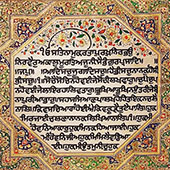Home / Resources / Gurmukhi Manuscript - Style Writing / The Traditional Lipi and Writing Practice with Paintī (35) Akhars
Design Resource
Gurmukhi Manuscript - Style Writing
Ik Onkar Passion Project Development
by
The Gurmukhī Lipi includes a total of paintī (35) letterforms and the proto script form has a total of (Gurmukhi complete traditional Varnamala, Figure 4a; Gurmukhi Unicode Chart, Figure 4b). Based on the traditional character set of paintī (35: ੪੫) Gurmukhī letterforms, the correct writing sequence was applied to develop chain-like continuous lines of each letterform/ akhar [Fig. 9].
Figure 9. The traditional painti akhars / 35 letters in Gurmukhi script (9a), the Unicode complete character set of proto-gurmukhi (9b) | The Unicode Standard, Version 13.0
Manuscript-style Writing Practice:
Selections and Synthesis for Ik Onkar project
The choice of traditional chain-like and modular grid inclusive manuscript writing scroll forms were an instrumental offspring from the old manuscript-style specimens of writings of hymns, etc. in Gurmukhī as part of Punjabi scriptures as well as few symbolic references from The Granth Sahib pages. The context here is based on historical evolutions of the script in manuscripts and applying for the current passion project.
- The Manuscript style has a long history in case of the 500-year-old Gurmukhī script and later researchers in 20th century times have shared cues that Gurmukhi script was developed by showcasing some of the earliest Sikh manuscripts including the Guru Harshai Pothi and Govindwal pothis of 16th CE (Mann, 2008).
- Her aim has been to achieve rigorous practice of correct stroke formations, understand letter constructions in a continuous, manuscript style and increase the muscle memory of the hand in relation to proportionate, balanced letter shape constructions in smaller sizes of modulated, continuous writing with different tools.
- The writing composition by the author for her writing practice of each akhar in chain-compositions, written with different tools and ink hues has been a deliberate composition style (Figure 10 to Figure 19)
- This later helped select the most appropriate letter shapes that were further digitized in Tayasui app (an iOS app) for churning out form possibilities with letters (Figure 12 and 13, section 3.2).
- The baseline grid of the horizontals in the notebook retains the left to right flow of each letter construction and the simulation/ repetitions help create a modular letter composition for each letterform (Figure 10).
- In each composition of individual letterforms; a predisposed distribution of letters written with different tools is a deliberate choice in the practice.
Figure 10. Practice spread of the Gurmukhi akhar ਖ (pronounced kha'khaa: ਖ਼ੱਖ਼ਾ) in continuous, modular grid and executed with pencil and ink-based tools as part of Ik Onkar passion project
- Introduction
- Holy Gurmukhi Script - Birth and Developments
- The Gurmukhi Akhars / Alphabets
- The Patrons and Manuscript-Style Written Granths
- The Traditional Lipi and Writing Practice with Paintī (35) Akhars
- Culture-Form Associations
- Categorization in the Ik Onkar Series
- The Personality Mapping
- Digitizing Few Selective Akhars
- Conclusions
- References
- Downloads
- Contact Details
- Credits



